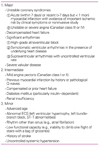Anesthesia for Non-cardiac Surgery in the Patients with Cardiac Disease
Article information
Abstract
Perioperative myocardial infarction is a major cause of morbidity and mortality in patients who undergo non-cardiac surgery, while an increasing number of patients with a coronary artery disease are presenting for surgery. In order to cope with this problem, one should first evaluate risk factors of these complications, and then manage the patient at risk to reduce or eliminate the risk factors. Risk assessment evaluates patients' co-morbidities and exercise tolerance, as well as the type of surgery to be performed, to determine the overall risk of perioperative cardiac complications. Previous or current cardiac disease, diabetes, and renal insufficiency all confer higher risks for perioperative cardiac complications. Poor exercise tolerance and high-risk surgical procedures (e.g., vascular, prolonged thoracic, or abdominal operations) also predict worse perioperative outcomes. Stress testing should be reserved for patients at moderate to high risk undergoing moderate- or high-risk surgery and those who have poor exercise capacity. After the assessment of the risk of cardiac complications, one should take measures to reduce it, including medical therapy and coronary intervention. Medical therapy using beta blockers, statins, and alpha-2 agonists may be effective to reduce perioperative risk and to obviate the need for more invasive procedures in high-risk patients. Coronary intervention should be performed for those patients who are indicated independent of the non-cardiac surgery. There appears to be no single best myocardium-protective anesthetic management, and therefore, the choice of anesthesia and intraoperative monitors is left at the discretion of the anesthesia care team.


